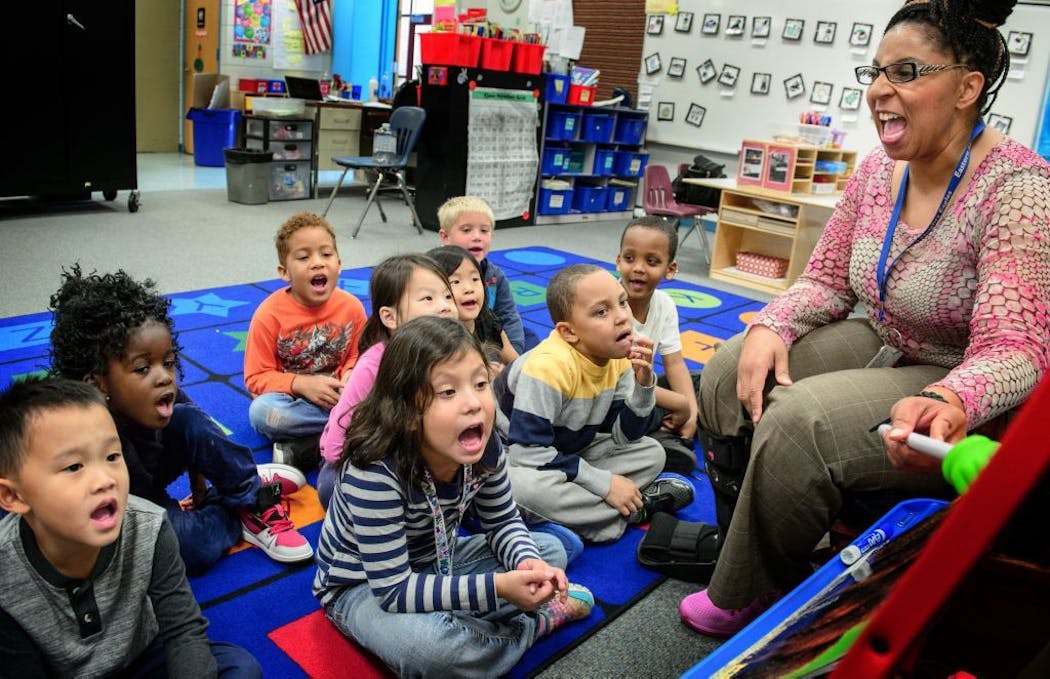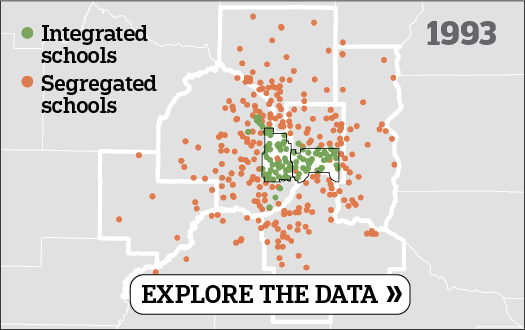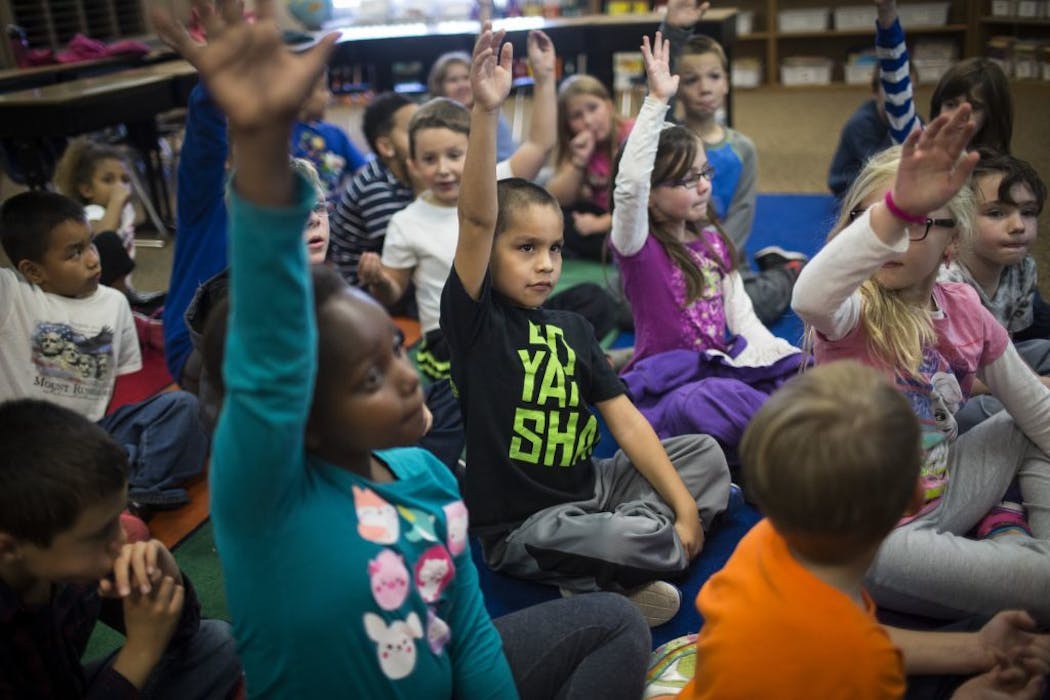Elementary students in Minneapolis and St. Paul attend schools that are more racially segregated than they have been in a generation.
More than half of elementary schools in the two districts now have 80 percent or more minority students. In Minneapolis, a district that was fully integrated in the 1980s, two schools have student populations that are almost entirely white and 19 schools are more than 80 percent minority, according to a Star Tribune analysis of enrollment data.
Meanwhile, many once overwhelmingly white suburban districts are increasingly diverse, a development that researchers say should produce far better educational outcomes for minority students. In Shakopee, minority enrollment has more than doubled since 2000, and district officials have drawn boundaries to ensure those students are distributed among its six elementary schools.
The resegregation of urban schools, while a national phenomenon, has been cited as one reason students of color in Minneapolis and St. Paul so badly trail their white peers in test scores, graduation rates and other measures of progress. Test scores in the most minority-concentrated schools lag integrated schools in the metro by about 25 percentage points.
"We are at a real crossroads in Minnesota," said Shakopee schools superintendent Rod Thompson. "When Minneapolis and St. Paul are on the verge of failure, as a suburb we have to realize we are all in this together."
Backlash to segregation
A number of forces have combined to make Minneapolis and St. Paul schools increasingly segregated. Immigration has transformed the demographic profile of the school-age population in both cities, complicating integration efforts. In St. Paul, 76 percent of elementary school students are children of color.
The rise of independent charter schools, the advent of choice programs, which allow students to attend schools outside their home districts, and the lure of private or religious schools have also contributed to the situation. So, too, have policy choices, such as the decisions within the last decade or so to end busing or promote neighborhood schools.
Both districts are grappling with how to solve a problem that they admit has gotten worse over time. The St. Paul teachers union wants the district to end a program that put renewed emphasis on neighborhood schools. Minneapolis leaders are discussing adding special programs to North Side high schools to attract white families. They also might redraw school boundaries.
A more sweeping solution is sought by local civil rights lawyer Daniel Shulman. He's preparing a lawsuit to force the state to reconfigure school districts, so students in Minneapolis and St. Paul will share classrooms with suburban children.
"That is the only thing that has been shown to be effective in other cities," Shulman said.
Brenda Cassellius, the state's education commissioner, doesn't think a lawsuit will be successful. While the state continues to provide districts with financial aid to integrate schools, Casselius said she believes all-minority schools can succeed.
"There are some spectacular stories out there of schools beating the odds," she said.
Once models of diversity
For a time, elementary schools in Minneapolis and St. Paul were models of integration.
A 1972 federal court order said no Minneapolis school could have more than 35 percent minority students. To comply, Minneapolis began busing students outside neighborhoods.
From 1987 to 1991, no Minneapolis elementary school had a racial makeup of 80 percent white or nonwhite. St. Paul had the same diversity by 1995.
But the demographics of the cities and districts were changing rapidly and dramatically. The proportion of minority students enrolled in Minneapolis soared from just 15 percent in 1978 to more than 50 percent in 1990. St. Paul saw a comparable increase.
Starting in the early 1990s, the urban districts in the Twin Cities said they could not keep up with state integration rules, which limited the percentage of students of color in a school. At the same time, federal and state commitment to racial integration began to diminish.
In 1991, the now-defunct State Board of Education decided districts within the seven-county metro area needed to design a desegregation plan together or lose state aid. Political opposition killed that idea and by 1998, the state issued an opinion saying it could not legally encourage integration, unless segregation had been intentional.
"Many places did not integrate their schools because of this opinion. They thought it would be illegal," said Myron Orfield, a University of Minnesota law professor and director of the school's Institute on Metropolitan Opportunity. "No state has ever seen a policy like this one."
The advent of open enrollment and more minority families moving to the suburbs helped change the face of suburban schools.
On average in the suburbs, 34 percent of public elementary schoolchildren are minorities, up from 6 percent in 1990. But some schools are much higher. In Brooklyn Center, for example, 86 percent of elementary students are nonwhite.
Thompson, the Shakopee superintendent, said the district was purposeful in the way it redrew boundaries to accommodate more minority families. Enrollment boundaries were created that ensured no school had a concentration of minority students or white students.
"We've been spot on to make sure our elementary schools are the same," he said.
District at 'odds with itself'
The same cannot be said for Minneapolis and St. Paul. Both districts have made decisions in recent years that have further segregated schools.
In St. Paul, Superintendent Valeria Silva's Strong Schools, Strong Communities plan did away with many citywide magnet programs in order to steer more students to neighborhood schools — re-establishing the school as the heart of the community. In 2011, when the plan was introduced, the district described it as its best chance at easing persistent achievement gaps, and argued in a letter to the NAACP that it would not "create greater segregation."
But Yusef Mgeni, a former district administrator serving on the NAACP's executive board, cites the growing number of elementary schools with 95 percent students of color — nine last school year compared with five in 2011 — as evidence of a district at "odds with itself" in the effort to close achievement gaps. The schools, he said, are full of students bringing a "wheelbarrow of challenges."
In 2009, facing a decline in enrollment, Minneapolis Public Schools shut down several magnet schools and once again said students should attend school close to where they live. But facing opposition from some parents, the school board voted against one part of that plan that would have sent more children from the largely white Bryn Mawr neighborhood to North and Patrick Henry high schools in largely minority north Minneapolis.
"That is my one major regret," said Minneapolis school board member Carla Bates. "It was wrong. Regardless of the idea and threat that they'll just leave, which is always the threat, there are other places that have integrated and families haven't left."
Bates said the district now looks like two education systems, one resembling Baltimore, the other Edina. Bethune, a school in the Near North neighborhood of Minneapolis, has 95 percent minority enrollment. Fewer than 17 percent of Bethune students were proficient on the state math tests last year. At Lake Harriet Lower, in southwest Minneapolis, nearly nine out of 10 students are white, and nearly 88 percent of its students met math standards last year. Teachers at Lake Harriet Lower have an average of 20 years' experience, nearly three times the average of Bethune teachers.
The ability of families to shift districts via open enrollment means Minneapolis and St. Paul cannot integrate on their own, Bates said.
More than a third of Minneapolis' school-age children and a quarter of those in St. Paul attend a charter or private school, or a district outside the city.
Planning a better balance
Minneapolis officials are quietly studying enrollment and demographic data to come up with plans to create a better racial balance. Interim Superintendent Michael Goar declined requests by the Star Tribune to discuss those plans.
As part of its current contract talks, the St. Paul Federation of Teachers is asking the district to pledge to abandon its Strong Schools, Strong Communities program and work with the union to "enact policies that will intentionally integrate segregated schools."
Union organizer Paul Rohlfing told district negotiators that the union wanted to lay the groundwork for a "community conversation" around segregation.
The district has no intention of scrapping Strong Schools, Strong Communities, said Michelle Walker, its chief executive. She cites the recent introduction of a West Side Montessori magnet program — open to residents across the city — that could foster integration.
The reality, Walker said, is that St. Paul is unusual in its makeup, with no predominant ethnic group, and as such, the true test for its leaders is: "How do we respect the diversity around the district?"
--
About the data
To determine the extent of segregation, the Star Tribune analyzed public school enrollment data, provided by the Minnesota Department of Education, for the 1980-81 through 2014-15 school years. The data showed the number of students in each elementary school as of Oct. 1 each year, broken down by white, black, Asian, American Indian and Hispanic. The newspaper categorized each school, in each year, as segregated if 80 percent or more of students were white or if 80 percent or more were non-white, a higher measure than the 75 percent used by the National Center for Education Statistics. The analysis included all public elementary schools, not including charters, in Hennepin, Ramsey, Washington, Dakota, Anoka, Scott and Carver counties.
Alejandra Matos • 612-673-4028 alejandra.matos@startribune.com
MaryJo Webster • 612-673-1789 maryjo.webster@startribune.com
Anthony Lonetree • 651-925-5036 anthony.lonetree@startribune.com

A tale of 124 hoarded Minnesota cats has at least a hundred happy endings

Walz, St. Paul leaders urge support for copper wire theft bill: 'We've got to get in front of it'
Body of missing canoeist, 15, recovered from southwest Minnesota lake

High winds flipped a FedEx truck traveling on Bong Bridge in Duluth




